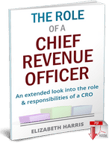
Chief Revenue Officers (CRO) and Chief Marketing Officers (CMO) share a common goal: to improve a company’s brand architecture and positioning, thereby driving leads, sales, and profits. For companies that already have a solid marketing platform - and even for those that do not - understanding how to provide strategic leadership to accomplish this goal can be difficult. The following considers how to leverage customer research in order to improve your position as a leader and enhance brand architecture:
Collecting Customer Research: Qualitative vs. Quantitative
There are two ways to collect data about customers and potential customers: through qualitative and quantitative research. Too often, CROs or CMOs fail to prioritize both elements, focusing on one or the other, only. Both are critical to improving brand recognition and perception.
Quantitative research is used to quantify, or measure, customers’ opinions, preferences and desires in a meaningful way, collecting real statistics that can then be used, allowing a company to make marketing decisions that are data-based. For example, quantitative research reveals precisely how a customer is interacting with a brand, i.e. how many customers are purchasing product A vs. product B. Of course, in terms of marketing, quantitative data can measure things such as sources of leads, time spent on a particular page, and the rate of conversions. This information is extremely valuable to CROs and CMOs, who can leverage this data to make meaningful and effective changes.
Qualitative research is also important, and its value should not be overlooked. Qualitative research is usually more exploratory and general, and is used to develop hypotheses for quantitative research, measuring opinions and motivations rather than specifics. For example, qualitative research measures how customers feel about products or services, or what they would like to see differently. Again, this can be used by CMOs and CROs to make significant branding changes, and can be especially helpful in A/B testing.
Remember: customer research should be used in conjunction with market research for the most effective collection of data that can be used by leaders to create a strategic plan for leveraging data and improving a brand.
Leveraging Customer Research
Once you have collected customer (and market) research, you can use that information in a targeted way to increase brand recognition. Knowing how to leverage critical data is essential.
- Select and condense key and actionable data. Post data collection, the next step is to summarize key and actionable data. You may be tempted to find value in every piece of customer data that you collect; resist this urge, focusing on the data pieces that hold the most weight and the largest potential for opportunity. If you are unsure which elements of data are “key and actionable,” consider these two questions:
- What is the marketing opportunity of this data? For example, if you discover that promoting one of your products more aggressively or in a different fashion would lead to a large increase in revenue, you should probably pursue it.
- How large of an impact could the data have? For example, if you change a feature of your website - such as going with a different text color or image - will you get a huge increase in traffic?
- Make targeted changes. Once you have narrowed down the most important consumer data, you will decide which data you will use to make targeted changes and reshape your brand. It is now time to implement those changes. There are minor and major marketing changes that you can make based on the data you have collected, ranging from updating images or logos, adding new (targeted and intentional) copy and content, implementing a customer give-away or contest, putting certain items on sale, issuing discounts or coupons, featuring products in paid advertising, and more.
- Measure effect. A campaign to collect and leverage customer research to improve a brand is not complete until data is used to make changes, those changes are implemented, and then the changes are measured. At this point, the cycle repeats itself, and customer data is once again collected to determine how the brand is faring.
Creating Profit-Driving Strategy Based on Customer Insights
As an executive, business owner, CRO or CMO, improving your responsibilities and providing strategic guidance through effective leadership to those in your company is essential. If you want to create a profit-driven approach to improve brand architecture and positioning, knowing how to collect and leverage customer research is essential. The more you understand about the behaviors of your customers, the more targeted your marketing strategy can be, providing you with the insight necessary to develop an aggressive revenue approach that is effective.
This is but one of the many responsibilities of a chief revenue officer. If this is of interest, you can read the full article here >
For a more extensive description of a chief revenue office, you can get the ebook here >
The Role of a Chief Revenue Officer
This ebook will help you study and define the role of a Chief Revenue Officer in depth, proving the job of a CRO is more than just a glorified VP of Sales. With a more thorough understanding of the CRO role, you will be better prepared to develop a company’s business model, provide needed strategic leadership, and grow profitable revenues.

